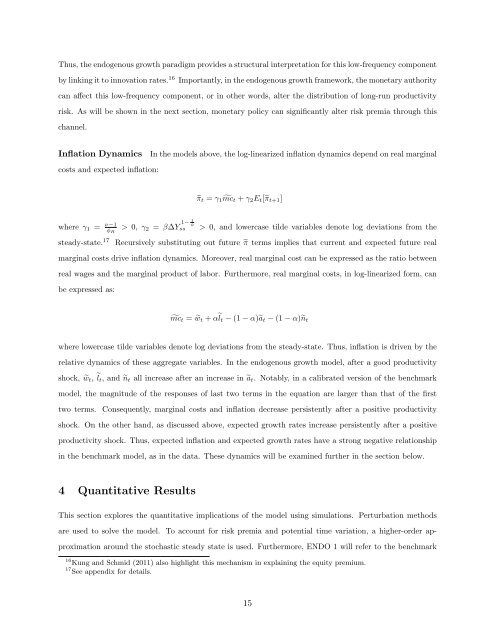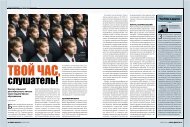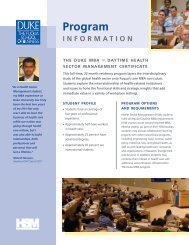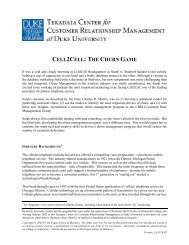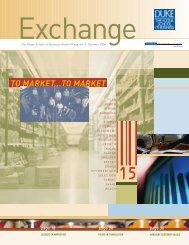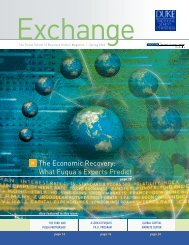Equilibrium Growth, Inflation, and Bond Yields - Duke University's ...
Equilibrium Growth, Inflation, and Bond Yields - Duke University's ...
Equilibrium Growth, Inflation, and Bond Yields - Duke University's ...
You also want an ePaper? Increase the reach of your titles
YUMPU automatically turns print PDFs into web optimized ePapers that Google loves.
Thus, the endogenous growth paradigm provides a structural interpretation for this low-frequency component<br />
by linking it to innovation rates. 16 Importantly, in the endogenous growth framework, the monetary authority<br />
can affect this low-frequency component, or in other words, alter the distribution of long-run productivity<br />
risk. As will be shown in the next section, monetary policy can significantly alter risk premia through this<br />
channel.<br />
<strong>Inflation</strong> Dynamics In the models above, the log-linearized inflation dynamics depend on real marginal<br />
costs <strong>and</strong> expected inflation:<br />
where γ1 = ν−1<br />
φR > 0, γ2 = β∆Y<br />
1 1− ψ<br />
ss<br />
�πt = γ1 �mct + γ2Et[�πt+1]<br />
> 0, <strong>and</strong> lowercase tilde variables denote log deviations from the<br />
steady-state. 17 Recursively substituting out future �π terms implies that current <strong>and</strong> expected future real<br />
marginal costs drive inflation dynamics. Moreover, real marginal cost can be expressed as the ratio between<br />
real wages <strong>and</strong> the marginal product of labor. Furthermore, real marginal costs, in log-linearized form, can<br />
be expressed as:<br />
�mct = �wt + α � lt − (1 − α)�at − (1 − α)�nt<br />
where lowercase tilde variables denote log deviations from the steady-state. Thus, inflation is driven by the<br />
relative dynamics of these aggregate variables. In the endogenous growth model, after a good productivity<br />
shock, �wt, � lt, <strong>and</strong> �nt all increase after an increase in �at. Notably, in a calibrated version of the benchmark<br />
model, the magnitude of the responses of last two terms in the equation are larger than that of the first<br />
two terms. Consequently, marginal costs <strong>and</strong> inflation decrease persistently after a positive productivity<br />
shock. On the other h<strong>and</strong>, as discussed above, expected growth rates increase persistently after a positive<br />
productivity shock. Thus, expected inflation <strong>and</strong> expected growth rates have a strong negative relationship<br />
in the benchmark model, as in the data. These dynamics will be examined further in the section below.<br />
4 Quantitative Results<br />
This section explores the quantitative implications of the model using simulations. Perturbation methods<br />
are used to solve the model. To account for risk premia <strong>and</strong> potential time variation, a higher-order ap-<br />
proximation around the stochastic steady state is used. Furthermore, ENDO 1 will refer to the benchmark<br />
16 Kung <strong>and</strong> Schmid (2011) also highlight this mechanism in explaining the equity premium.<br />
17 See appendix for details.<br />
15


